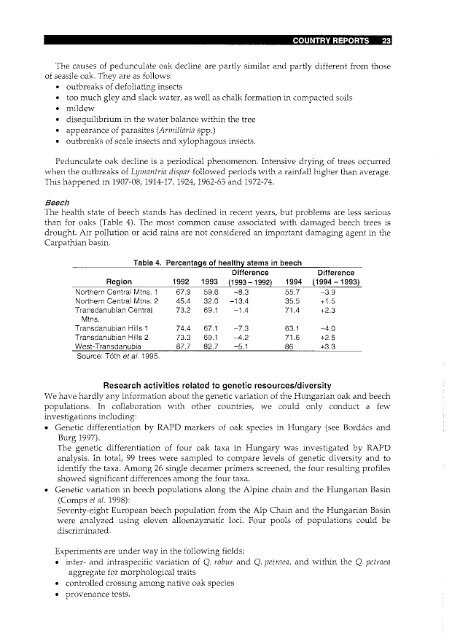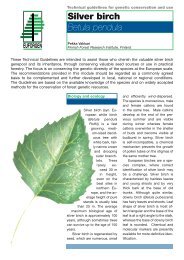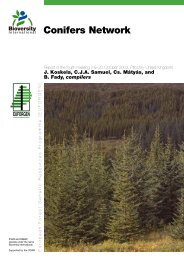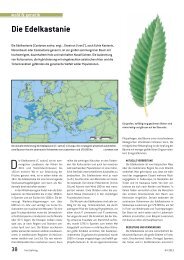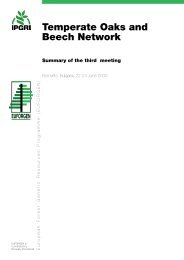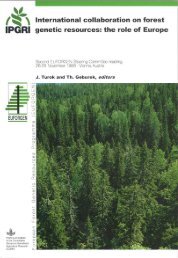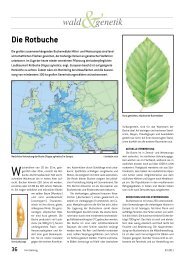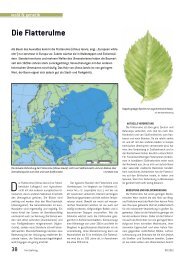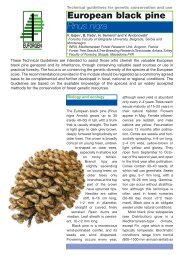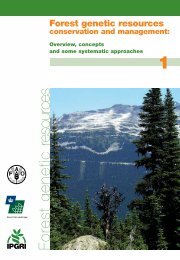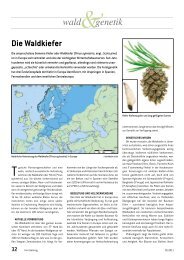Download PDF - Euforgen
Download PDF - Euforgen
Download PDF - Euforgen
Create successful ePaper yourself
Turn your PDF publications into a flip-book with our unique Google optimized e-Paper software.
eGUNliR¥ REeGRliS 23<br />
The causes of pedunculate oak decline are partly similar and partly different from those<br />
of sessile oak. They are as follows:<br />
III outbreaks of defoliating insects<br />
III too much gley and slack water, as well as chalk formation in compacted soils<br />
III mildew<br />
III disequilibrium in the water balance within the tree<br />
III appearance of parasites (Armillaria spp.)<br />
III outbreaks of scale insects and xylophagous insects.<br />
Pedunculate oak decline is a periodical phenomenon. Intensive drying of trees occurred<br />
when the outbreaks of Lymantria dispar followed periods with a rainfall higher than average.<br />
This happened in 1907-08, 1914-17, 1924, 1962-65 and 1972-74.<br />
Beech<br />
The health state of beech stands has declined in recent years, but problems are less serious<br />
than for oaks (Table 4). The most common cause associated with damaged beech trees is<br />
drought. Air pollution or acid rains are not considered an important damaging agent in the<br />
Carpathian basin.<br />
liable 4. Percentage of health~ stems in beech<br />
Difference<br />
Difference<br />
Region 1992 1993 {1993 - 1992} 1994 (1994 -1993)<br />
Northern Central Mtns. 1 67.9 59.6 -8.3 55.7 -3.9<br />
Northern Central Mtns. 2 45.4 32.0 -13.4 35.5 +1.5<br />
Transdanubian Central 73.2 69.1 -1.4 71.4 +2.3<br />
Mtns.<br />
Transdanubian Hills 1 74.4 67.1 -7.3 63.1 -4.0<br />
Transdanubian Hills 2 73.3 69.1 -4.2 71.6 +2.5<br />
West-Transdanubia 87.7 82.7 -5.1 86 +3.3<br />
Source: T6th et al. 1995.<br />
Research activities related to genetic resources/diversity<br />
We have hardly any information about the genetic variation of the Hungarian oak and beech<br />
populations. In collaboration with other countries, we could only conduct a few<br />
investigations including:<br />
III Genetic differentiation by RAPD markers of oak species in Hungary (see Bordacs and<br />
Burg 1997).<br />
The genetic differentiation of four oak taxa in Hungary was investigated by RAPD<br />
analysis. In total, 99 trees were sampled to compare levels of genetic diversity and to<br />
identify the taxa. Among 26 single decamer primers screened, the four resulting profiles<br />
showed significant differences among the four taxa.<br />
III Genetic variation in beech populations along the Alpine chain and the Hungarian Basin<br />
(Comps et al. 1998):<br />
Seventy-eight European beech population from the Alp Chain and the Hungarian Basin<br />
were analyzed using eleven alloenzymatic loci. Four pools of populations could be<br />
discriminated.<br />
Experiments are under way in the following fields:<br />
III inter- and intraspecific variation of Q. robur and Q. petraea, and within the Q. petraea<br />
aggregate for morphological traits<br />
III controlled crossing among native oak species<br />
III provenance tests.


